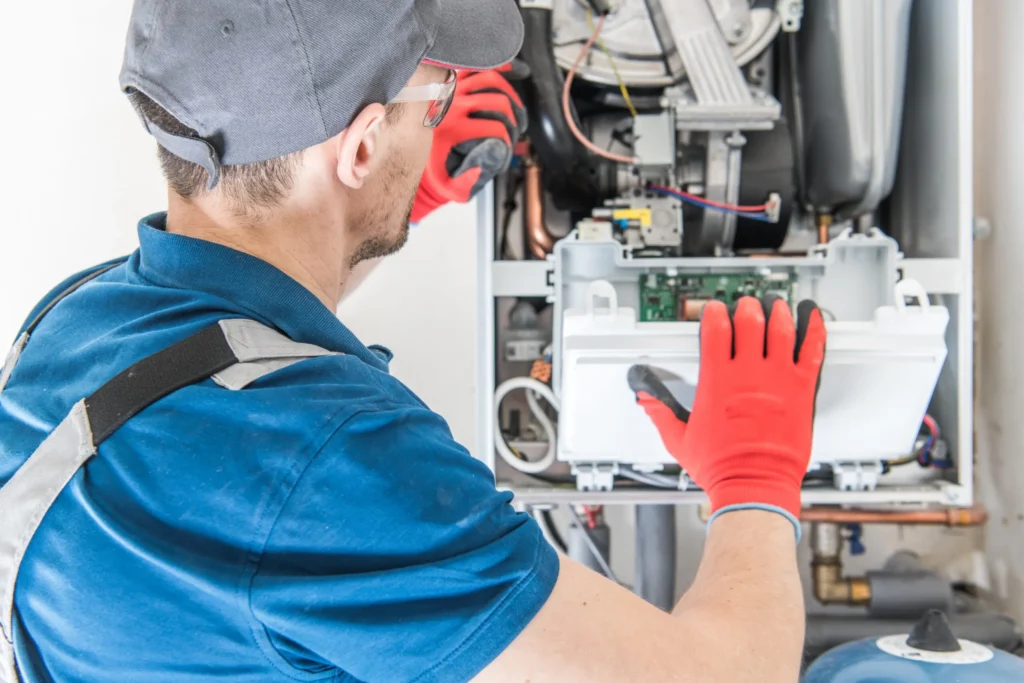Furnace Repair In McCordsville, IN, And Surrounding Areas
The sudden drop in temperature signals a potential issue with your furnace. For homeowners and business proprietors, facing furnace problems is common. Dealing with a broken furnace may be frustrating, particularly in the winter when comfort is paramount. But assistance is easily accessible. At LCS Heating & Cooling, we understand the inconvenience caused by furnace issues, and we’re here to offer efficient furnace repair services in McCordsville, IN.

With our assistance, you can promptly restore warmth and comfort to your property.
Highlighting the Importance of Professional Furnace Repair
Maintaining a well-functioning furnace is crucial as winter approaches, particularly in McCordsville. Let’s explore why professional furnace repair is vital for residents and businesses in the area.
- Optimal Comfort: A properly functioning furnace ensures a comfortable indoor environment, especially during cold seasons. Professional repair services guarantee consistent warmth throughout your property.
- Energy Efficiency: A malfunctioning furnace can lead to energy wastage and higher utility bills. Professional repairs enhance energy efficiency, reducing consumption and saving money in the long run.
- Preventing Costly Repairs: Addressing minor issues promptly prevents them from escalating into significant problems, thus avoiding expensive repairs in the future.
- Safety Assurance: Malfunctioning furnaces can pose safety hazards like carbon monoxide leaks or electrical fires. Professional repair includes safety checks to ensure the well-being of occupants.
- Prolonged System Lifespan: Maintaining your furnace with timely repairs and routine maintenance prolongs its lifespan and helps you avoid replacing it sooner.
Don’t wait for colder weather to address furnace issues. Schedule your repair with LCS Heating & Cooling today for a worry-free winter.
Expert Furnace Repair Solutions
Whether it’s a minor glitch or a major malfunction, you can rely on LCS Heating & Cooling for prompt and reliable service. Our repair services include:
- Diagnostic Assessments: Pinpointing the root cause of furnace issues through thorough assessments.
- Component Replacements: Precise replacement of faulty components like thermostats or blower motors.
- System Tune-Ups: Regular maintenance to keep your furnace running smoothly.
- Efficiency Optimization: Enhancing furnace efficiency to reduce energy bills.
- Emergency Repairs: Promptly address urgent heating needs, especially during colder months.
Choose us for your furnace repair requirements in McCordsville and experience top-notch service and expertise.

Emergency Service
LCS Heating & Cooling: Your Trusted Partner for Furnace Repair
When choosing a service provider for your furnace repair needs, we understand that you’re looking for reliability, expertise, and exceptional customer service. That’s why we go above and beyond to deliver an unparalleled experience for our valued customers. Here are some key points that make us stand out:
- Customer-Centric Approach: Our clients are the center of our attention. We are committed to establishing enduring bonds between people founded on openness, respect, and trust. From the moment you contact us, you’ll experience our dedication to providing personalized service tailored to your needs and preferences.
- Skilled Technicians: Our team comprises highly qualified individuals with years of HVAC industry expertise. We continually invest in education and training to ensure our professionals have the most up-to-date information and abilities to provide excellent furnace repair services.
- Commitment to Excellence: Quality is at the heart of everything we do. Whether it’s diagnosing a problem, performing repairs, or providing maintenance services, we adhere to the highest standards of excellence to ensure the job is done right the first time, every time.
When you choose us for your furnace repair necessities, you select a trusted partner committed to your satisfaction and comfort.
Beat the Chill Before Winter Arrives: Schedule Your McCordsville Furnace Repair Today!
Ready to experience unparalleled expertise and exceptional service for your furnace repair needs in McCordsville, IN? Don’t let the chill catch you off guard – take action today and schedule your appointment with LCS Heating & Cooling. Our team of experts is prepared to restore warmth and comfort to your house or place of business.


